Family : Bothidae

Text © Giuseppe Mazza

English translation by Mario Beltramini
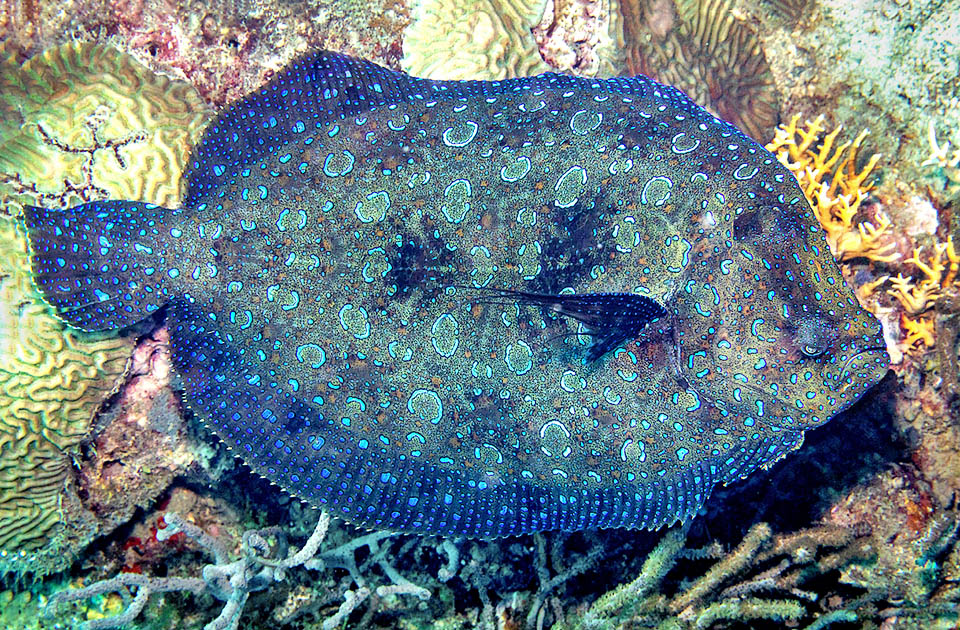
Known as Peacock flounder due to its multicoloured livery, Bothus lunatus is present on both sides of the tropical Atlantic © Allison & Carlos Estape
Bothus lunatus (Linnaeus, 1758), known as Plate fish or Peacock flounder due to the imaginative and colourful drawings on the side not resting on the seabed, belongs to the class of the Actinopterygii, the ray-finned fishes, to the order of the Pleuronectiformes, rich of more than 800 species often important for the human nutrition like European Plaice (Pleuronectes platessa) from which gets its name, and to the family of the Bothidae.
This group, diffused in the tropical and temperate waters of all oceans, counts nowadays 20 genera and more than 170 species, like the analogous Flowery flounder (Bothus mancus) living in the Indo-Pacific and the Wide-eyer flounder (Bothus podas) of the Mediterranean, much more modest in size.
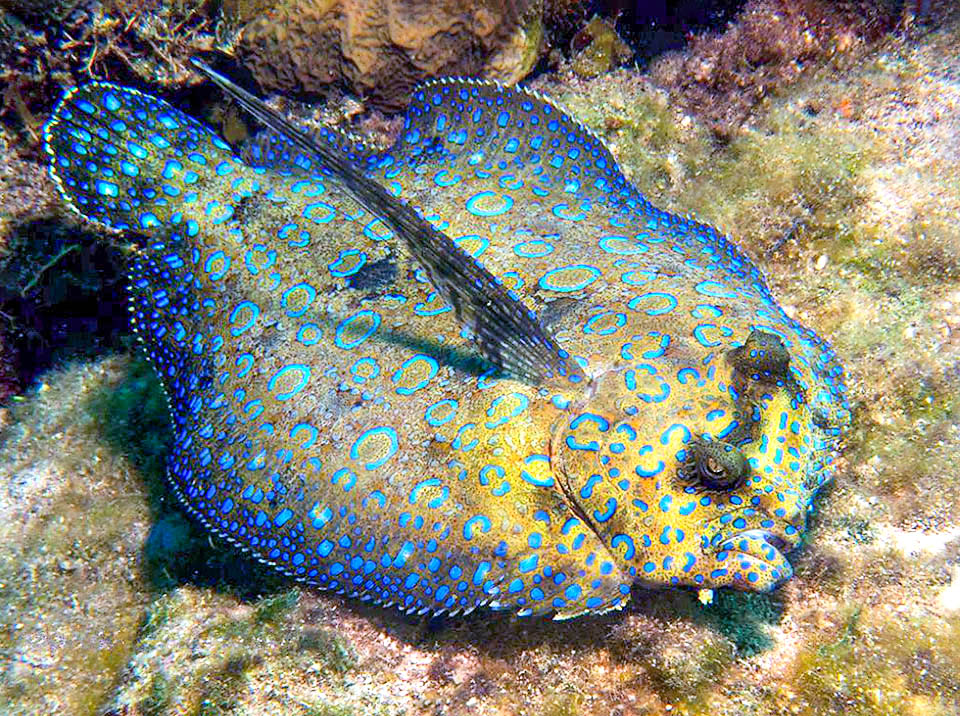
We find it in America from Bermudas and Florida to Brazil, and has reached in the Old World the Gulf of Guinea © Mickey Charteris
The name of the genus Bothus, given by Rafinesque (1810), is the one that Aristotle assigned to these animals, and since 1200, we find in various languages the roots “bot, both, bott” to indicate some flat fishes. But this genus might also come from the Greek “βου” (Boù), an intensifier united to “Θεο” (theo), to run, because rather than swimming the flounders appear to be running on the seabed with fast undulating movements of the fins.
The specific term lunatus, shaped like a moon in Latin, is conversely a clear reference to its splendid ring drawings.
Zoogeography
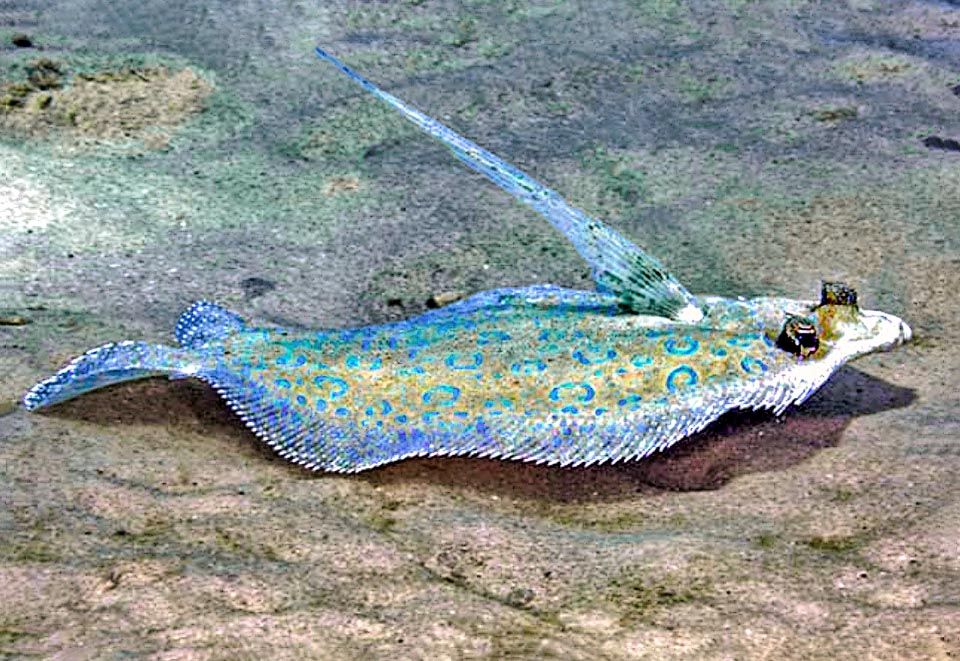
More like swimming it seems running leaping across the seabed with fast undulatory movements holding the pectoral sited on the side of the eyes raised like a banner © Allison & Carlos Estape
Bothus lunatus is present on both tropical sides of the Atlantic.
In America we find it starting from Bermudas, Florida and Bahamas, all over the Caribbean Sea, up to Venezuela and Brazil, but is absent in the Gulf of Mexico.
Like other Caribbean species it has then reached the archipelago of Trindade and Martim Vaz, Ascension Island, in the middle of the ocean, to then finally land along the African coasts of the Gulf of Guinea.
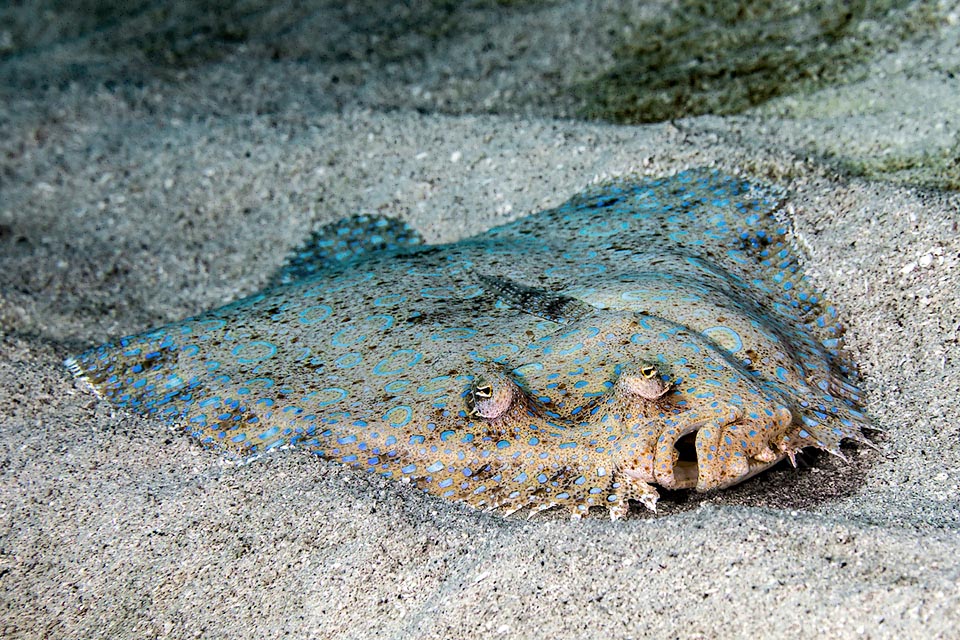
Like all Bothidae, it lives on the seabeds leaning on the right side, and the eye present in the larval stage on this side has moved to the left © Allison & Carlos Estape
Ecology-Habitat
It’s a fish frequent in the reefs found mainly in shallow waters, usually no deeper than 20 m, but that may get down up to about 100 m.
It moves on the sandy bottoms, between one madrepore and another, close to the submerged prairies of phanerogams or among the roots of the mangroves. It perfectly imitates the gravelly bottoms with coral rubble and it is not rare to find it partially covered by sand while resting or staying in ambush, with the eyes protruding like periscopes from the seabed.
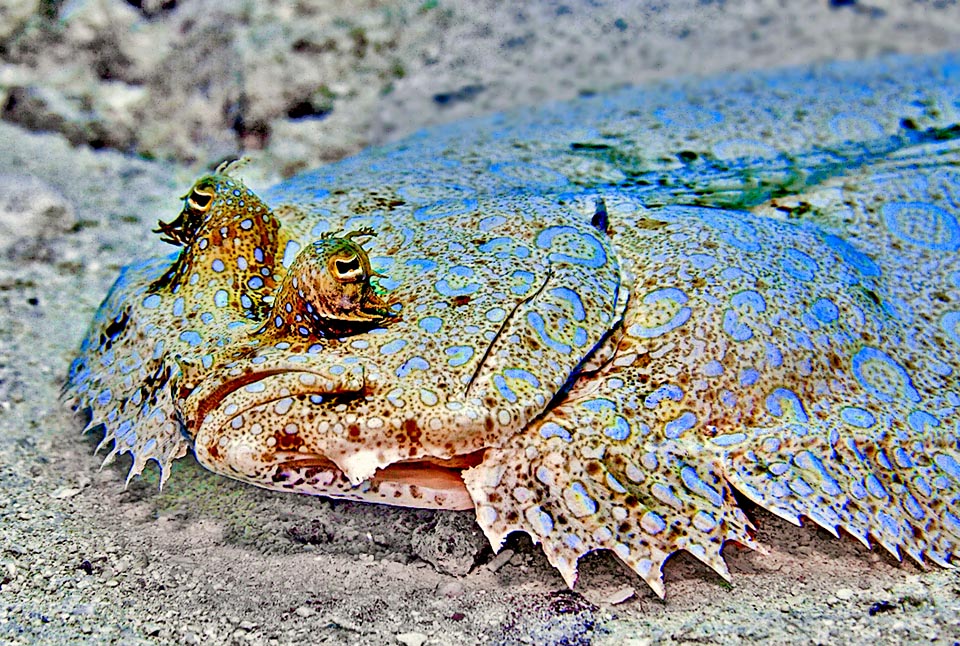
Also the pelvic fins have moved. The right one, longer than the other, has moved forward and here is well visible under the lower eye © Allison & Carlos Estape
At times, being sure of its mimicry, it can be found even over a rock in full sight with spots that imitate the support.
Morphophysiology
The Peacock flounder can reach the length of 46 cm but the current size is about 35 cm.
The body, flat and oval, is about twice as long as it is wide, and seen that like all other Bothidae lives on the bottoms leaning on the right side, the eye present at the larval state on this side has moved to the left one during the metamorphosis.
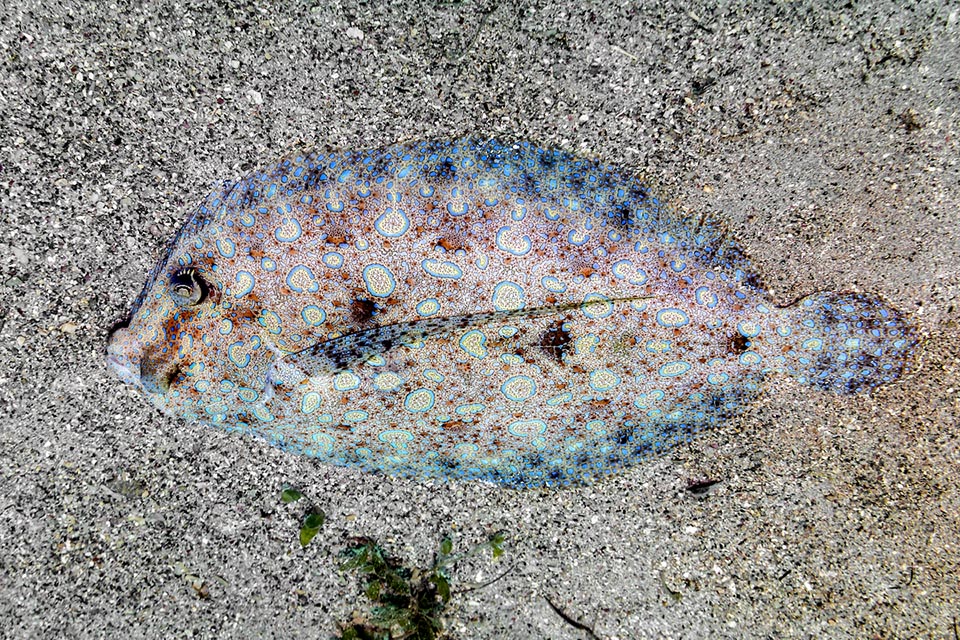
There is only one lateral line present on the upper side. It’s formed by 83-95 sensorial scales on which we note 3 black spots, less visible at times © Allison & Carlos Estape
Looking at it from above we note then a characteristic notch before the lower eye that distinguishes it from the other species of genus Bothus.
The eyes, raised above the body, move independently, allowing the fish to look at the same time at multiple sides.
They are the ones who drive the chromatophores that adapt to the environment, the drawings and the colours of the fish, in fact when they are absent or are covered by sand, this one cannot interact and due to lack of information the exposed side remains evenly dark.
The mouth has on both jaws 8-10 tiny teeth, for grabbing quickly the ill-fated passing by.
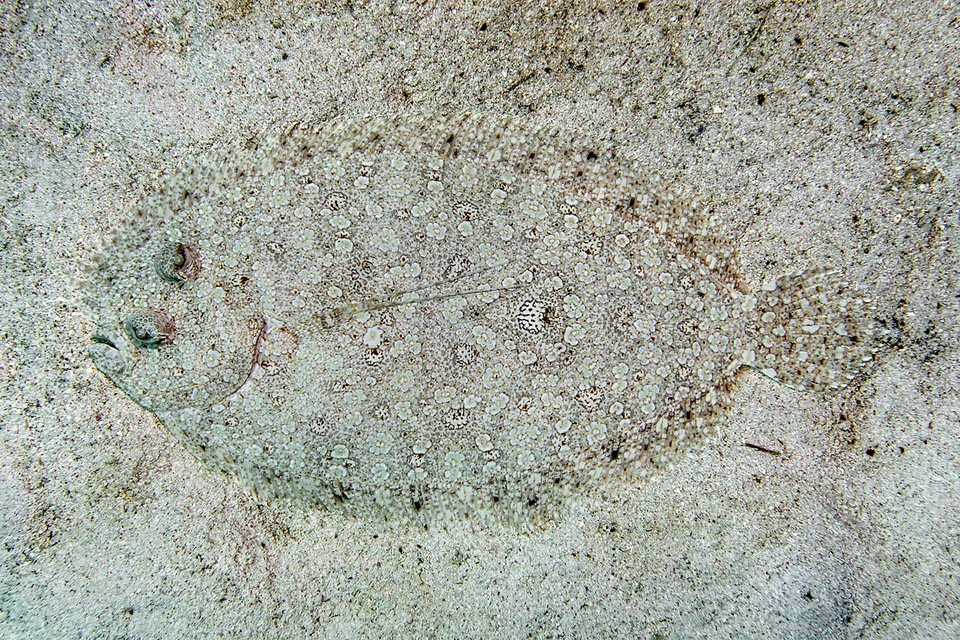
It sets ambush for passing fishes, while the eyes look around driving the colours of the livery that perfectly imitates the surrounding bottoms © Allison & Carlos Estape
The dorsal and the anal fins practically surround the body of the Peacock flounder. THe first has 92-99 unarmed rays, and the second, symmetrical but shorter, 71-76 rays.
The pectoral fin located on the side of the eyes is particularly elongated with 11-12 rays. It is straightened while swimming like a banner and serves for making signals to the conspecifics and can reach the caudal peduncle.
Also the pelvic fins have moved. The right one has stretched out more than the other moving forward, and now is well visible under the lower eye.
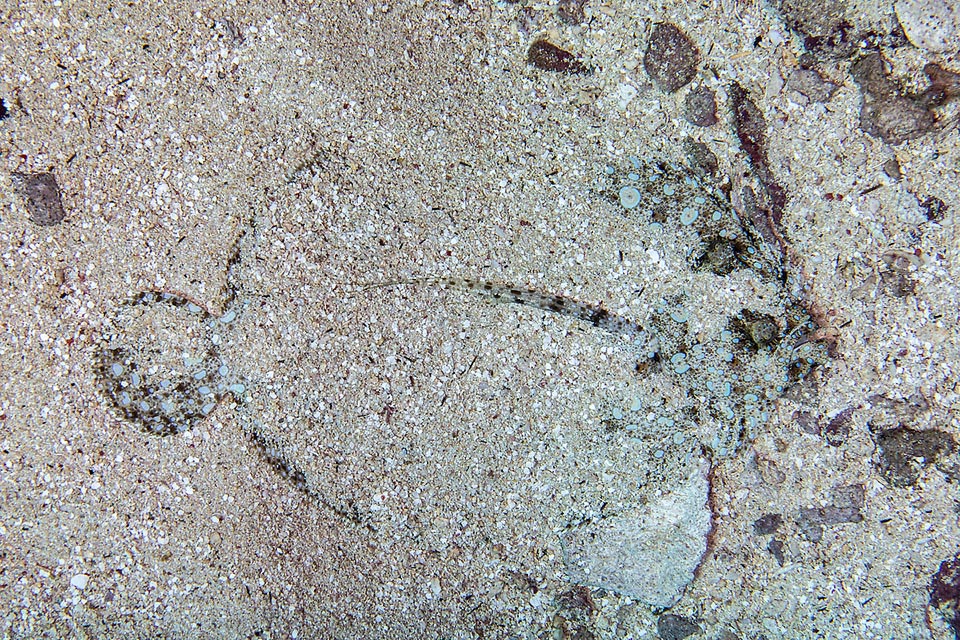
When covered by sand it’s even more difficult to be seen, but doesn’t escape fishes like sharks and rays who locate the magnetic field of the preys © Allison & Carlos Estape
The swim bladder is missing, present only in the larval stage, and there is only one lateral line placed on the upper side with 83-95 sensorial scales on which usually align three more or less evident black spots.
For the rest the livery is grey or beige with the characteristic blue ocelli, colour resumed also by the mottling on the fins, whilst the side resting on the bottom is, like all Pleuronectiformes, whitish.
Ethology-Reproductive Biology
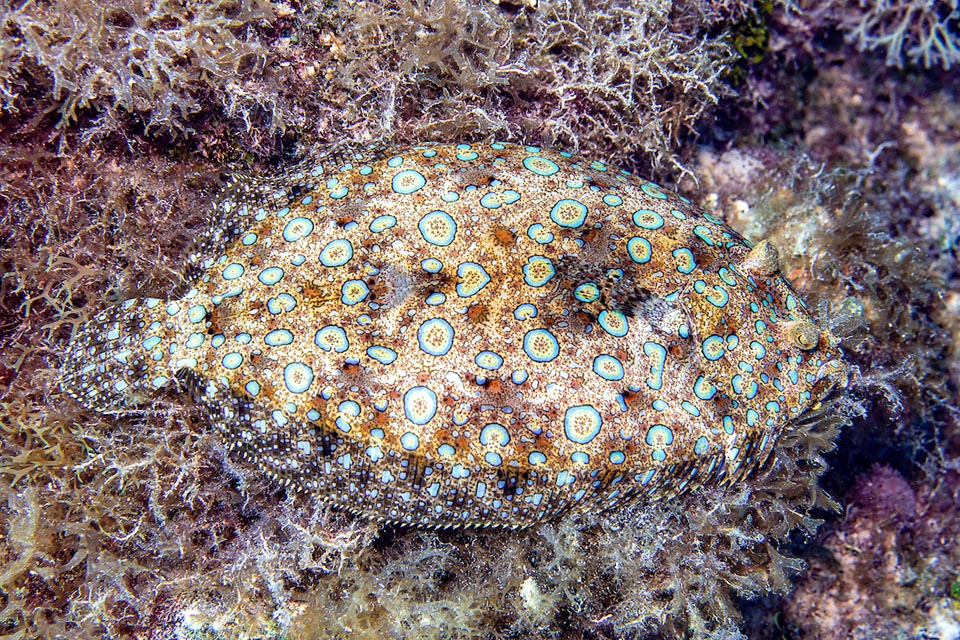
The chromatophores may create instantly whatever colour and also here disappears from sight despite the showy livery © Allison & Carlos Estape
Bothus lunatus has been seen nourishing also of various grunt fishes like Haemulon flavolineatum and of modestly sized benthic species, but also of crustaceans and sometimes of small octopusses.
It is a territorial fish. The males, slightly bigger than the females, with more spaced eyes and the longer filiform rays of the pectoral, control an area of 50-360 square metres where they allow only the females to enter, assigning to each one a parcel of 20-50 square metres.
So they have a small harem and reproduce all the year round with those ready to spawn with a precise ritual. Male and female get closer with the pectoral of the ocular side erect and touch the snout arching the body.
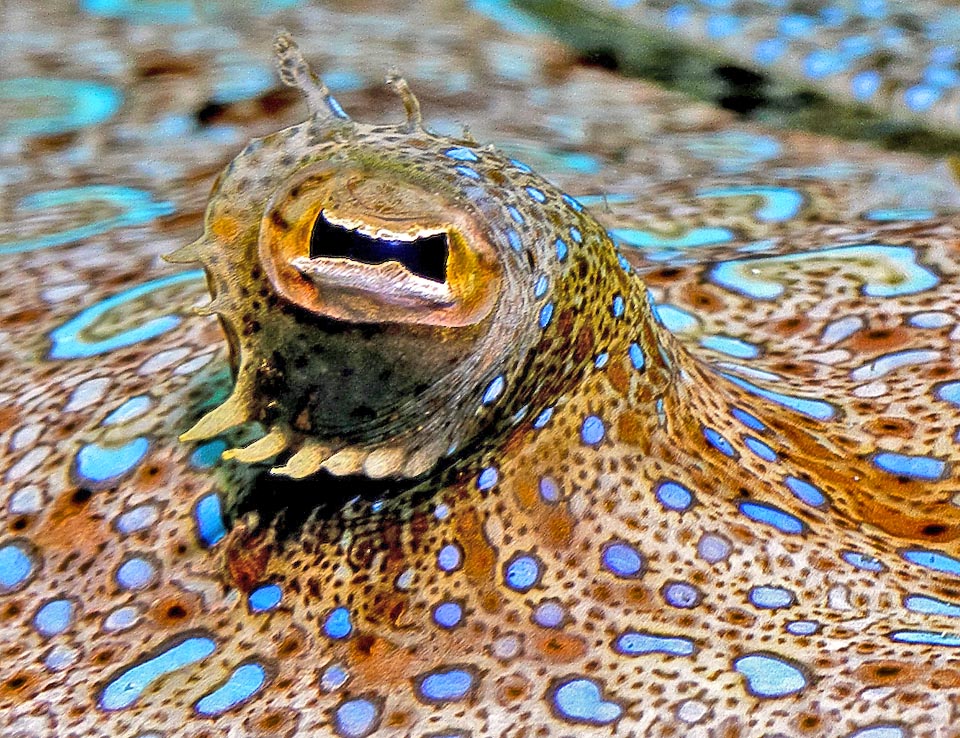
The eyes protruding like periscopes from the seabed move independently for a perfect vision on any side © Allison & Carlos Estape
The female is often not decided and runs away but later on starts again.
When this moves up and down the pectoral, probably a signal, the two ascend the water column for about 2 m releasing together clouds of ovules and sperm.
The male controls the success of the operation and then the couple separates running in opposite directions while the eggs disperse carried away by the currents.
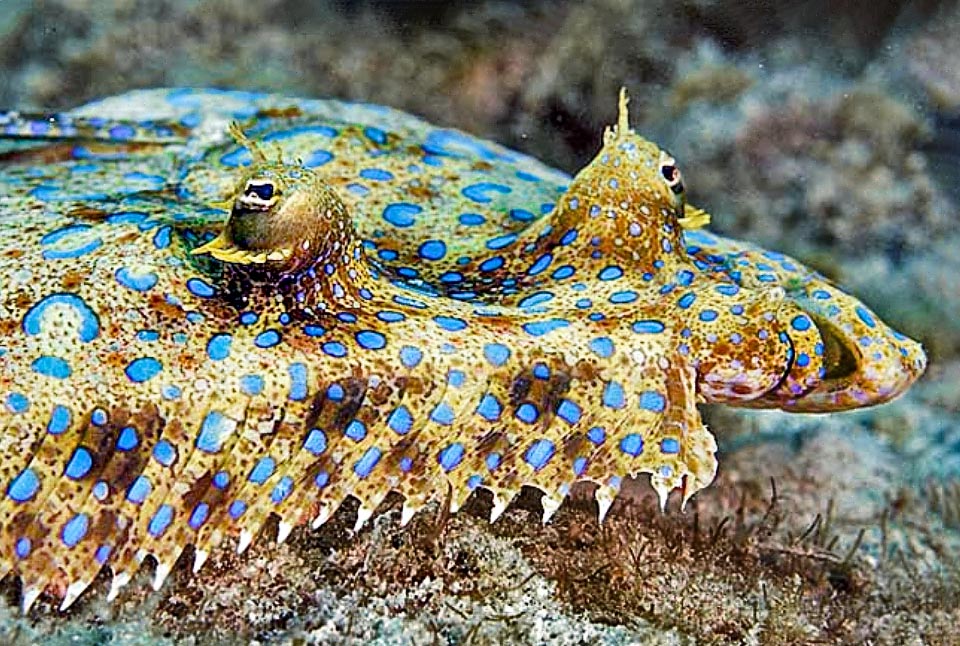
Here they are at work. Right, we note the mouth and the characteristic notch before the lower eye typical to this species © Allison & Carlos Estape
The planktonic larvae, almost transparent, have the swim bladder and do not have teeth.
Initially the eyes stand on the two sides. While growing the body of the larva gets flat and somewhat round with huge fins. While the teeth emerge and the swim bladder disappears, the right eye migrates on the left side of the body, where the pigments concentrate, through an opening that forms where the dorsal fin separates from the skull.
After this metamorphosis the larvae approach the seabed and the small fishes will grow benthic with a lifespan of about 10 years.
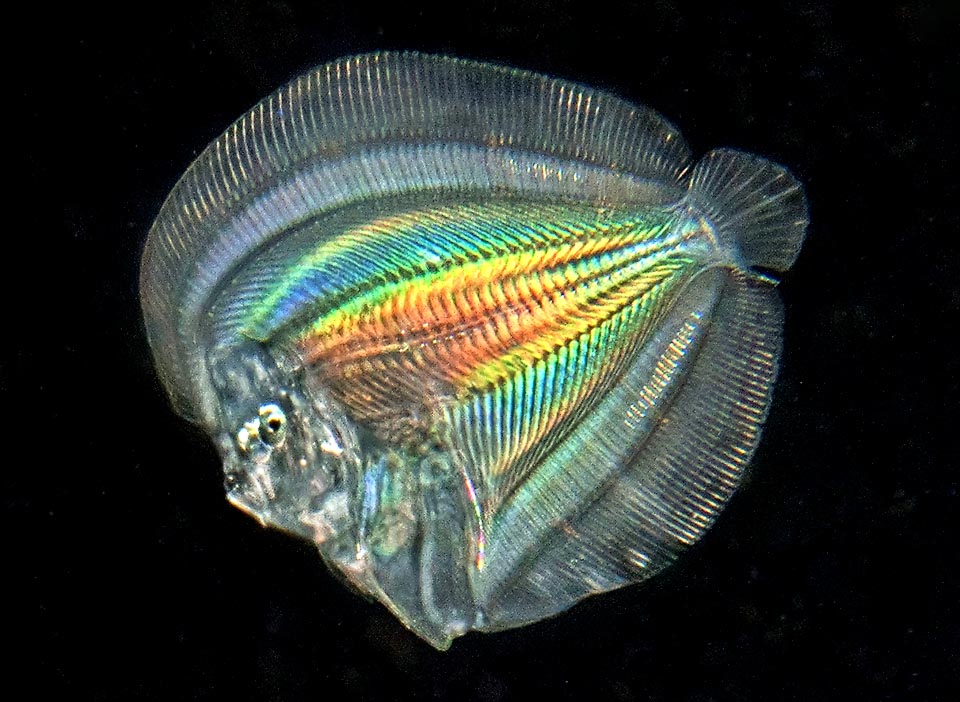
Here is a larva of genus Bothus. Eyes are still normal but that on the right will move to the left through a slit placed between the dorsal fin and the skull © Mickey Charteris
Among the natural foes of Bothus lunatus stand chiefly sharks and rays, who locate it also when it is well hidden under the sand due to the electric field emitted, but are often attacked by the sea breams and by the notorious Pterois volitans incautiously introduced in the Caribbean.
The juveniles, as we have seen with Synodus intermedius, often end up in the mouth also of other benthic fishes.
The resilience of the species is very low, as are needed at least 14 years to redouble the populations, but though being an edible fish, the fishing vulnerability is still moderate, marking 36 on a scale of 100.
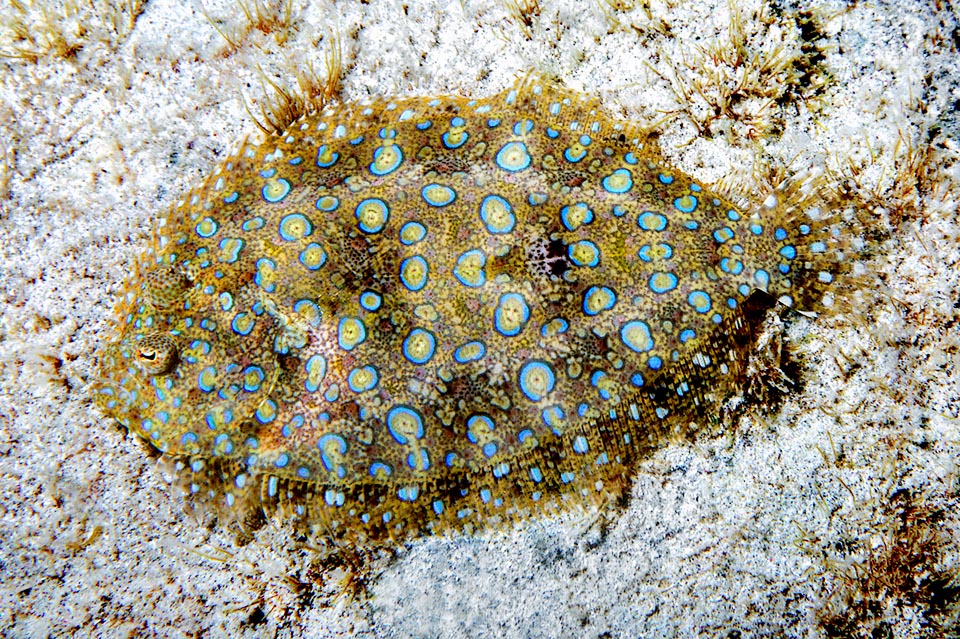
6 cm juvenile. The resilience of Bothus lunatus is very low and is often caught in artisanal and sport fishing, but the distribution is vast and it is not an endangered species © Allison & Carlos Estape
Bothus lunatus, often hosted in the public aquaria thanks to its beauty, appears consequently since 2012 as “LC, Least Concern” in the IUCN Red List of the endangered species.
Synonyms: Pleuronectes lunatus Linnaeus, 1758; Platophrys lunatus (Linnaeus, 1758); Rhomboidichthys lunatus (Linnaeus, 1758); Pleuronectes argus Bloch, 1783.
→ For general information about FISH please click here.
→ For general information about BONY FISH please click here
→ For general information about CARTILAGINOUS FISH please click here.
→ To appreciate the BIODIVERSITY of BONY FISH please click here.
→ To appreciate the BIODIVERSITY of CARTILAGINOUS FISH please click here.
